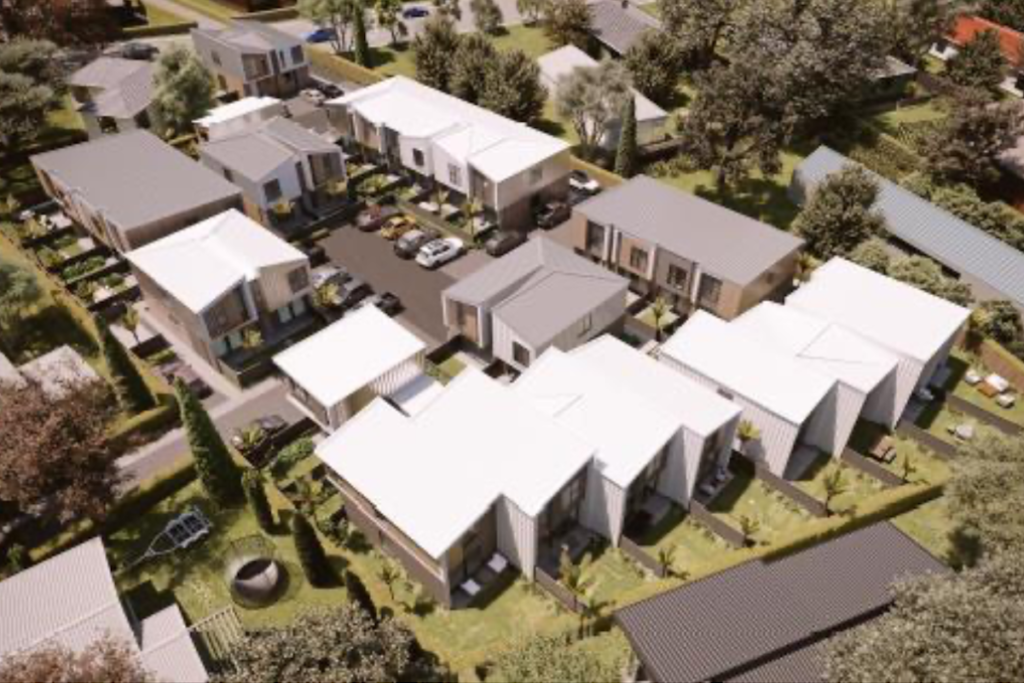What's New
13 October, 2021
Big Milford development part of record consent surge

A 32-unit housing development for Milford is among a record number of resource consents lodged in Auckland during lockdown.
The proposal to build on three combined sections near the East Coast Rd and Stanley Ave corner shops was lodged in late September. It shows the ambitious scale of some suburban developments on the drawing board.
Latest figures from Auckland Council also show that attached multi-unit dwellings make up the vast bulk of planning consent applications across the city.
“We’re at record consent numbers. We’ve never seen anything like this in the history of the city,” North Shore councillor and Planning Committee chairman Chris Darby told the Observer.
The private sector was responding to the need for more housing.
Darby said that of applications that won consent from city planners, 90 per cent were signed off as completed homes within two years.
The Milford application, in the name of Milford Villas Ltd, is one of the largest in the Devonport-Takapuna Local Board area for some time. It is for permission to demolish three existing homes on adjoining properties at 80 and 82 East Coast Rd and 7 Stanley Ave and to replace them with 30 two-storey attached dwellings and two standalone two-storey homes.
The blocks of terrace-style homes would have 2-3 bedrooms and a single parking space. The developers propose that the dual access would have one-way entry from East Coast Rd and exit onto Stanley Ave. They maintain the scale and design would be appropriate to the area, in the mixed-housing suburban zone.
Over the last few months, several other applications have been lodged from Sunnynook to Belmont for multi-unit developments containing a dozen or so dwellings.
Demand from developers for larger sections is adding fuel to the real-estate pricing fire.
Applications for consents in September for the local-board area are tracking at a similar number to pre-lockdown times. Most are to build additional homes on what have often been single-home properties.
The latest Auckland Monthly Housing Update shows that in August (during which lockdown was imposed from 17 August), a total of 2162 dwellings were consented city wide. In the year to August, 19,928 consents to build were issued and 14,178 completed homes had a code compliance certificate issued.
For the board area, 787 consents were lodged over 12 months, which is 18 per cent higher than the previous year. But figures were up even more, by 25 per cent, for the six months to August, compared with the same six-month period in 2020.
Of the city’s August consents, 65 per cent were for townhouses, flats, units, retirement village or other attached dwellings; 29 per cent were for houses and 6 per cent for apartments.
New residential parcels of land under 5000m2 were created under 907 consents in August. The total for the year was 8709.
Public-housing stock was also boosted, with land owned by Kainga Ora or the Tamaki Regeneration Company land making up 175 of the total dwellings consented in August.
A quarter of the city’s new housing development consented in August was inside the 1500m ‘walking catchments’ of the rapid transport network, the housing report shows. This proximity allows greater intensification and will come further into play as the council responds to the Government’s National Policy Statement on Urban Development.
Darby said attempting to hold the line on design provisions while it works through responding to the Government directive would be a challenge. “The Government is interested in quantities, Aucklanders too, but they [residents] will not like it if they just get quantity outcomes and not quality outcomes that will last forever.”
A non-notified proposal for a project on a similar scale to the Milford one was made last year for back sections opposite Takapuna Grammar. Neighbours were concerned about a shared driveway, safety and space issues. Council planners sent the proposal back to the applicants for more work to meet Unitary Plan rules. Later, one of the properties was put up for sale.
The Rangitoto Observer can be downloaded online here.

Please consider supporting The Rangitoto Observer by clicking here:

